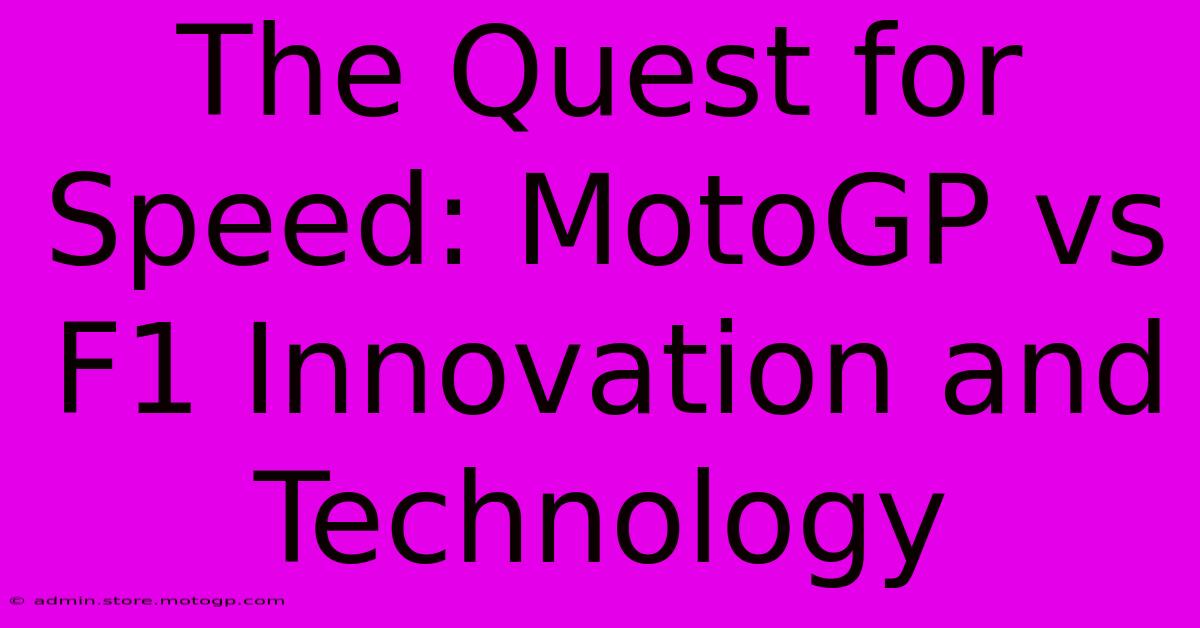The Quest For Speed: MotoGP Vs F1 Innovation And Technology

Table of Contents
The Quest for Speed: MotoGP vs F1 Innovation and Technology
The roar of the engines, the blur of speed, the breathtaking skill of the riders – Formula 1 and MotoGP represent the pinnacle of motorsport engineering. Both series relentlessly pursue incremental gains in performance, pushing the boundaries of innovation and technology. But while they share a common goal – ultimate speed – their approaches differ significantly. This article dives deep into the contrasting technological landscapes of MotoGP and F1, exploring the unique challenges and solutions each faces.
The Powertrain Paradox: Internal Combustion vs. Hybrid Power
One of the most striking differences lies in the powertrains. F1 cars utilize sophisticated hybrid power units, combining a 1.6-liter turbocharged V6 internal combustion engine with two motor generator units (MGUs). This complex system recovers energy during braking and deployment, boosting power and efficiency. The intricate energy management strategies employed by F1 teams are a testament to their advanced control systems.
MotoGP bikes, on the other hand, rely solely on powerful internal combustion engines. Currently, these are 1000cc four-stroke prototypes, a significant departure from the two-stroke screamers of the past. While seemingly simpler, the quest for horsepower in MotoGP requires intense focus on engine design, materials science, and aerodynamic optimization to maximize power output and efficiency within the strict regulations. The challenge lies in extracting maximum power from a relatively small engine while maintaining reliability over race distances.
Aerodynamics: Downforce vs. Drag Reduction
Aerodynamics play a crucial role in both series, but the approaches differ considerably. F1 cars generate substantial downforce, pressing them firmly to the track at high speeds, allowing for incredible cornering speeds. This is achieved through complex, meticulously designed wings and bodywork. The constant battle between maximizing downforce and minimizing drag is a key aspect of F1 engineering.
MotoGP bikes prioritize reducing drag, as minimizing air resistance is paramount to achieving high top speeds on straights. While some downforce is beneficial for stability, the focus remains on streamlining the motorcycle and rider to minimize drag, leveraging the slipstream effectively during races. This creates a different set of aerodynamic challenges, focusing on minimizing wake and maximizing efficiency at high speeds.
Tire Technology: Grip and Consistency
Tire technology is another area where both series showcase cutting-edge innovation. F1 utilizes bespoke tires supplied by a single manufacturer, Pirelli, meticulously designed for specific track conditions. The tire compounds, constructions, and strategies employed dramatically impact race performance. Understanding tire degradation and managing tire pressures is critical for success.
MotoGP employs similar tire strategies, albeit with a slightly different approach. Michelin provides tires for MotoGP, again focusing on adapting tire compounds to the unique demands of each track. However, the higher tire wear and tear resulting from the lean angles and aggressive riding style in MotoGP presents a unique engineering challenge, with tire management becoming a pivotal aspect of race strategy.
Electronics and Rider Aids: Control and Precision
Both F1 and MotoGP heavily leverage electronics to enhance performance and safety. F1 cars utilize advanced traction control, engine mapping, and other electronic aids, subtly influencing the car's behavior. These systems are constantly refined to maximize performance while staying within the sport's regulations.
MotoGP also utilizes sophisticated electronics, including traction control, wheelie control, and launch control. However, the rider's skill remains paramount. While these systems enhance safety and performance, mastering the interplay between the rider's skill and the electronic aids remains crucial. The balance between technological assistance and rider input is a delicate one.
The Future of Innovation: Sustainability and Beyond
Both F1 and MotoGP are actively exploring sustainable technologies for the future. F1's shift towards sustainable fuels and the increased focus on hybrid power units are notable examples. MotoGP is also exploring alternative fuels and more environmentally friendly materials.
Ultimately, the quest for speed in both F1 and MotoGP drives relentless innovation. While their technological approaches differ significantly, both series represent the peak of motorsport engineering, pushing the boundaries of what's possible and captivating audiences worldwide. The ongoing battle for supremacy on the track is mirrored in the relentless pursuit of technological excellence off it.

Thank you for visiting our website wich cover about The Quest For Speed: MotoGP Vs F1 Innovation And Technology. We hope the information provided has been useful to you. Feel free to contact us if you have any questions or need further assistance. See you next time and dont miss to bookmark.
Featured Posts
-
Easy Parking Solutions For F1 Austin
Feb 20, 2025
-
Moto Gp 23 On Ps 5 Experience The Thrill Of Victory
Feb 20, 2025
-
Motorcycle Racing A Test Of Courage And Endurance
Feb 20, 2025
-
Experience The Intensity Tnt Sports Moto Gp
Feb 20, 2025
-
Rv Parking At Circuit Of The Americas Everything You Need To Know
Feb 20, 2025
